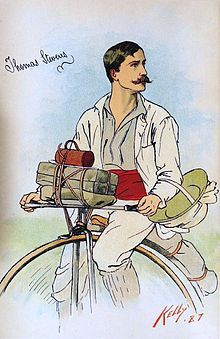 “Always use discretion and common sense. Be sure to have a sound and reliable machine…. It makes all the difference between pleasure and anxiety.”
“Always use discretion and common sense. Be sure to have a sound and reliable machine…. It makes all the difference between pleasure and anxiety.”
So wrote F. Freeman of London in 1883 in his essay “Hints on Bicycle Touring” in “The Cyclist and Wheel World Annual.”
I wonder if Thomas Stevens, left, had read the “hints” before setting off from San Francisco in 1884 to become the first person to ride a bicycle around the world — on a penny-farthing at that.
Many of the recommendations in Freeman's article hold true today; the best peace of mind comes from using a reliable bicycle on a tour. Some of the other suggestions, however, are wildly off base.
Hydration
Probably the worst advice from Freeman concerns what we call hydrating, keeping our body fluids topped off. Not drinking enough on a long bike ride can reduce our efficiency and cause headaches and muscle cramps.
Freeman, however, cautioned against drinking.
“Drink as little as possible; if you resist drinking you will not feel to want it. If necessary, rinse the mouth out with water. The more you drink the more you will perspire. … Milk, soda and milk, or a little oatmeal with water are generally considered best to drink.”
I don't know what Freeman had against perspiring. Perhaps English gentlemen did not perspire in those days.
Meals
As for eating, Freeman says it's OK to eat pretty much what you like; “Things nourishing and easily digested are best.”
Amen to that. But he recommends against eating pastry, which I know for a fact has fueled every bicycle tour in the last 50 years. In fact, that's why many people get into bicycling, in order to eat all the pastry they want.
Snacks
Freeman, of course, wrote his “hints” without the benefit of all the research that's been done in the last 130 years on the mechanical, physical, bioelectrical and biochemical functions of the human body.
He also wrote at a time before power bars, shots, gels and sports drinks. For a “sustainer” on the bike, “I think nothing is better or more convenient than any of Brand's meat preparations, such as B's Essence in tins, B's Meat Lozenges, or Concentrated Beef Tea in skins.”
Freeman also wrote at a time before lycra and other synthetic fabrics. “Always wear flannel next to the skin.”
Good ideas
Some of his other suggestions are as good today as they were in 1883:
“Confidence is everything…”
“Be sure to have a good and reliable brake…”
“Avoid, if possible, starting on a new saddle.”
“Always keep to the rules of the road; and do not make pedestrians unnecessarily jump, as it frightens them and they do not look very happy after it.”
Training
“Ride for practice as much as possible, the fortnight before starting a tour.” While two weeks might not seem like a lot, it's probably more riding than a lot of bicyclists get in, even today. To make up for lack of training, Freeman recommends riding moderate distances at first, then more miles day by day as the cyclist improves.
I don't know what type of bicycle luggage systems were available in Freeman's day, but he recommends just carrying a knapsack with 10 to 12 pounds of gear. Also, “A little light luggage may be conveniently carried over the bicycle head and strapped on to the handlebars.”
Freeman may have been the first ultralight bicycle tourist.
Reputation
He also cautioned against actions that might bring bicycling into disrepute; thereby preserving bicyclists' high esteem in the public today.
“Always behave as a gentleman and a credit to your club. Do not be seen loitering about outside of public houses. If riding on a Sunday, silence your bell while passing a church, and avoid clashing with people going to or coming away from church.”
Image of Thomas Stevens from Wikipedia.

Recent Comments